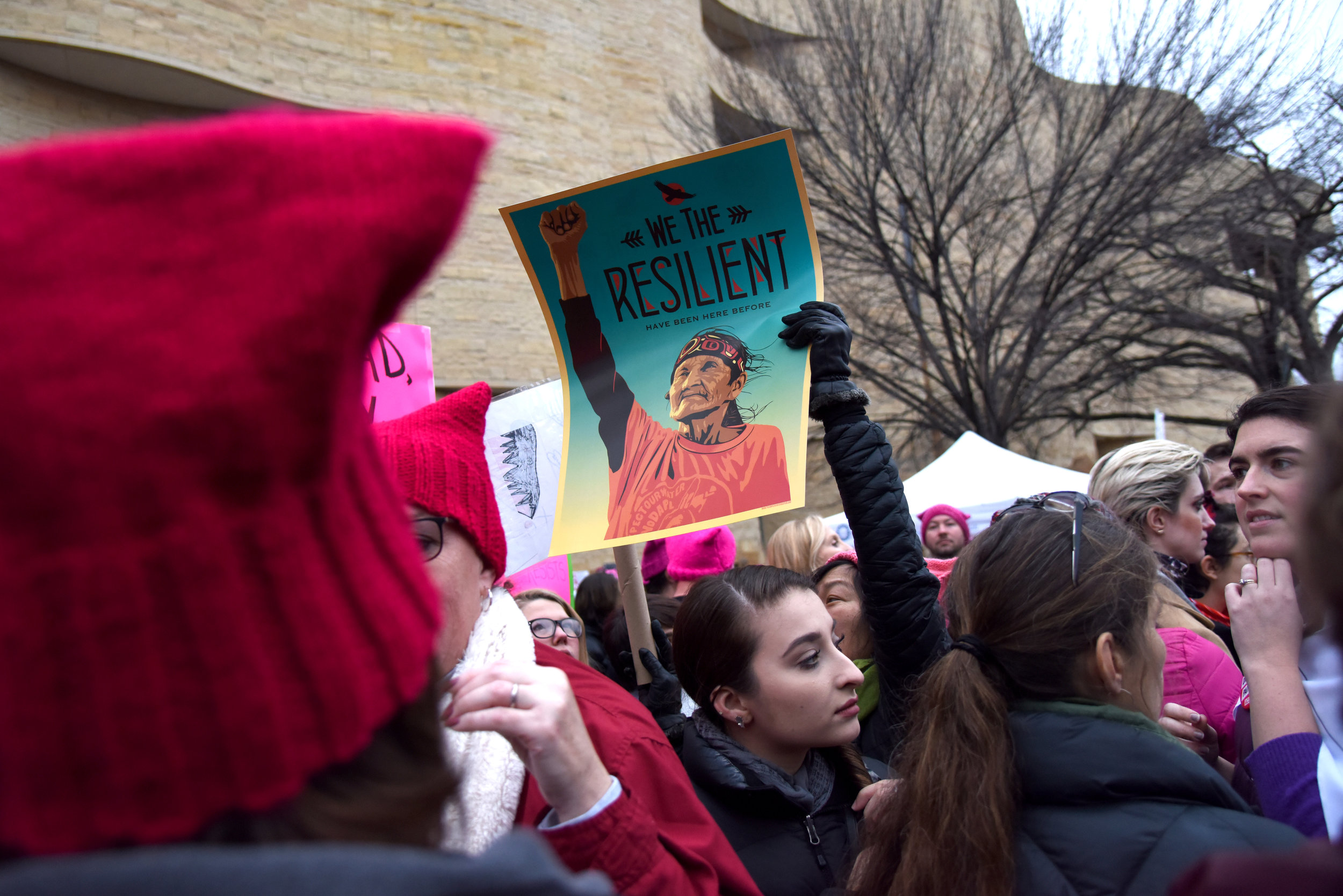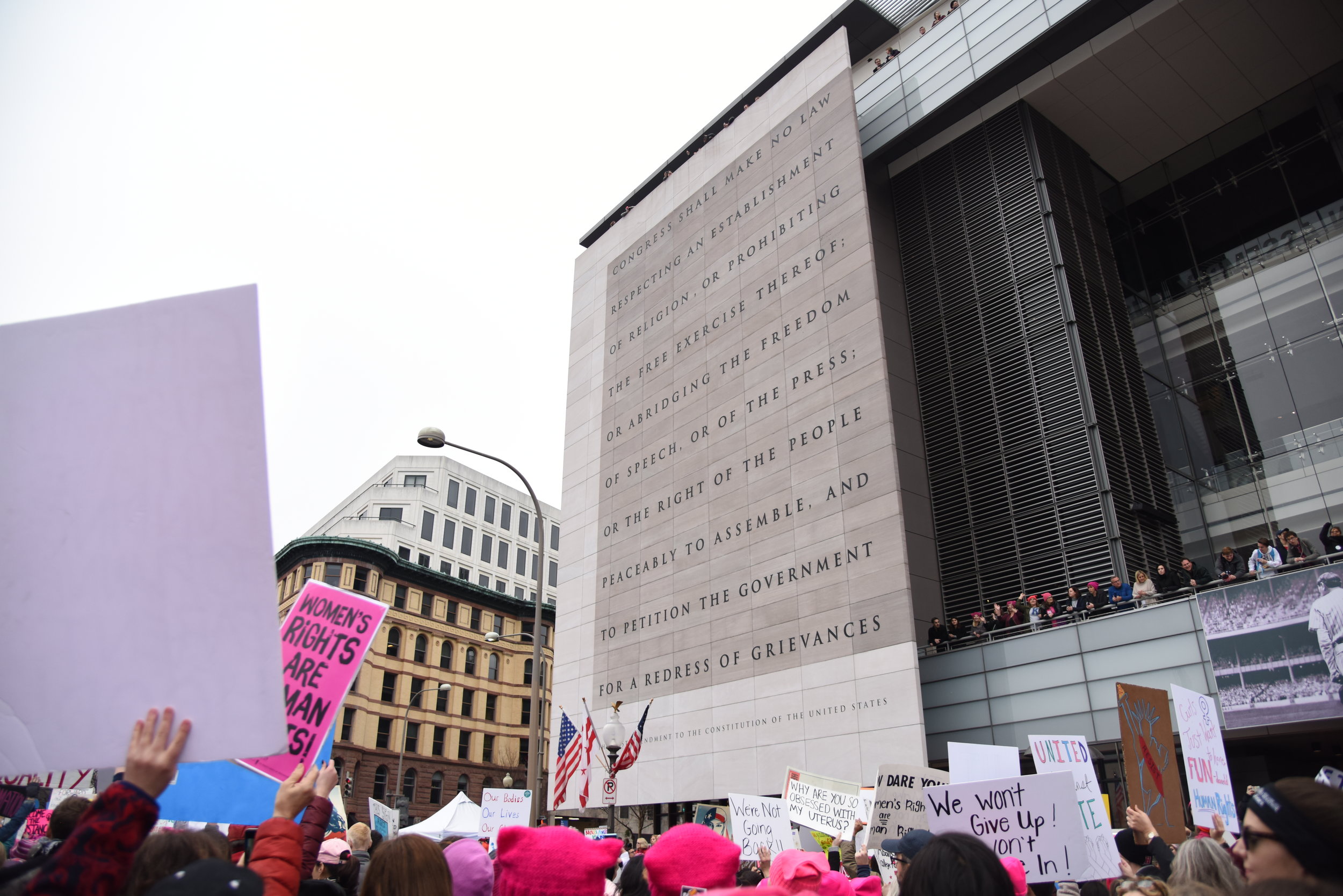
Marchers gather at the Union Station metro station in transit to the Women's March on Washington in Washington, D.C January 21st. The day of the Women's March, the Washington Metro system had its second-busiest day ever with over a million trips taken, considerably larger than Donald Trump's inauguration and second only to the first inauguration of Barak Obama.

A marcher holds up a poster - designed by artist Shepard Fairey as part of a series for the Women's March - in front of the Museum of the American Indian during the Women's March on Washington in Washington D.C. January 21, 2017.

Women listen to speeches at the Women's March on Washington Saturday in Washington, D.C.

Large crowds march past the U.S. Capitol at the Women's March on Washington Saturday in Washington, D.C.

A woman holds her child while listen to speeches at the Women's March on Washington January 21st in Washington, D.C. The march, which its organizers say was meant to "send a bold message to our administration on their first day in office," was the largest single-day protest in American history. The Washington march drew an estimated 440,000 to 500,000 people, and worldwide participation has been estimated at around 5 million.

A marcher chants during the rally at the Women's March on Washington in Washington, D.C. January 21st. The march, which its organizers say was meant to "send a bold message to our administration on their first day in office," was the largest single-day protest in American history. The Washington march drew an estimated 440,000 to 500,000 people, and worldwide participation has been estimated at around 5 million.

Large crowds march past the U.S. Capitol at the Women's March on Washington January 21st in Washington, D.C. The march, which its organizers say was meant to "send a bold message to our administration on their first day in office," was the largest single-day protest in American history. The Washington march drew an estimated 440,000 to 500,000 people, and worldwide participation has been estimated at around 5 million.

Two women march hand in hand past the U.S. Capitol at the Women's March on Washington January 21st in Washington, D.C. The march, which its organizers say was meant to "send a bold message to our administration on their first day in office," was the largest single-day protest in American history. The Washington march drew an estimated 440,000 to 500,000 people, and worldwide participation has been estimated at around 5 million.

Marchers walk past the Newseum, the museum of news, in Washington D.C. during the Women's March on Washington, January 21 2017. Carved on the front of the museum is the first amendment to the constitution.









Marchers gather at the Union Station metro station in transit to the Women's March on Washington in Washington, D.C January 21st. The day of the Women's March, the Washington Metro system had its second-busiest day ever with over a million trips taken, considerably larger than Donald Trump's inauguration and second only to the first inauguration of Barak Obama.
A marcher holds up a poster - designed by artist Shepard Fairey as part of a series for the Women's March - in front of the Museum of the American Indian during the Women's March on Washington in Washington D.C. January 21, 2017.
Women listen to speeches at the Women's March on Washington Saturday in Washington, D.C.
Large crowds march past the U.S. Capitol at the Women's March on Washington Saturday in Washington, D.C.
A woman holds her child while listen to speeches at the Women's March on Washington January 21st in Washington, D.C. The march, which its organizers say was meant to "send a bold message to our administration on their first day in office," was the largest single-day protest in American history. The Washington march drew an estimated 440,000 to 500,000 people, and worldwide participation has been estimated at around 5 million.
A marcher chants during the rally at the Women's March on Washington in Washington, D.C. January 21st. The march, which its organizers say was meant to "send a bold message to our administration on their first day in office," was the largest single-day protest in American history. The Washington march drew an estimated 440,000 to 500,000 people, and worldwide participation has been estimated at around 5 million.
Large crowds march past the U.S. Capitol at the Women's March on Washington January 21st in Washington, D.C. The march, which its organizers say was meant to "send a bold message to our administration on their first day in office," was the largest single-day protest in American history. The Washington march drew an estimated 440,000 to 500,000 people, and worldwide participation has been estimated at around 5 million.
Two women march hand in hand past the U.S. Capitol at the Women's March on Washington January 21st in Washington, D.C. The march, which its organizers say was meant to "send a bold message to our administration on their first day in office," was the largest single-day protest in American history. The Washington march drew an estimated 440,000 to 500,000 people, and worldwide participation has been estimated at around 5 million.
Marchers walk past the Newseum, the museum of news, in Washington D.C. during the Women's March on Washington, January 21 2017. Carved on the front of the museum is the first amendment to the constitution.